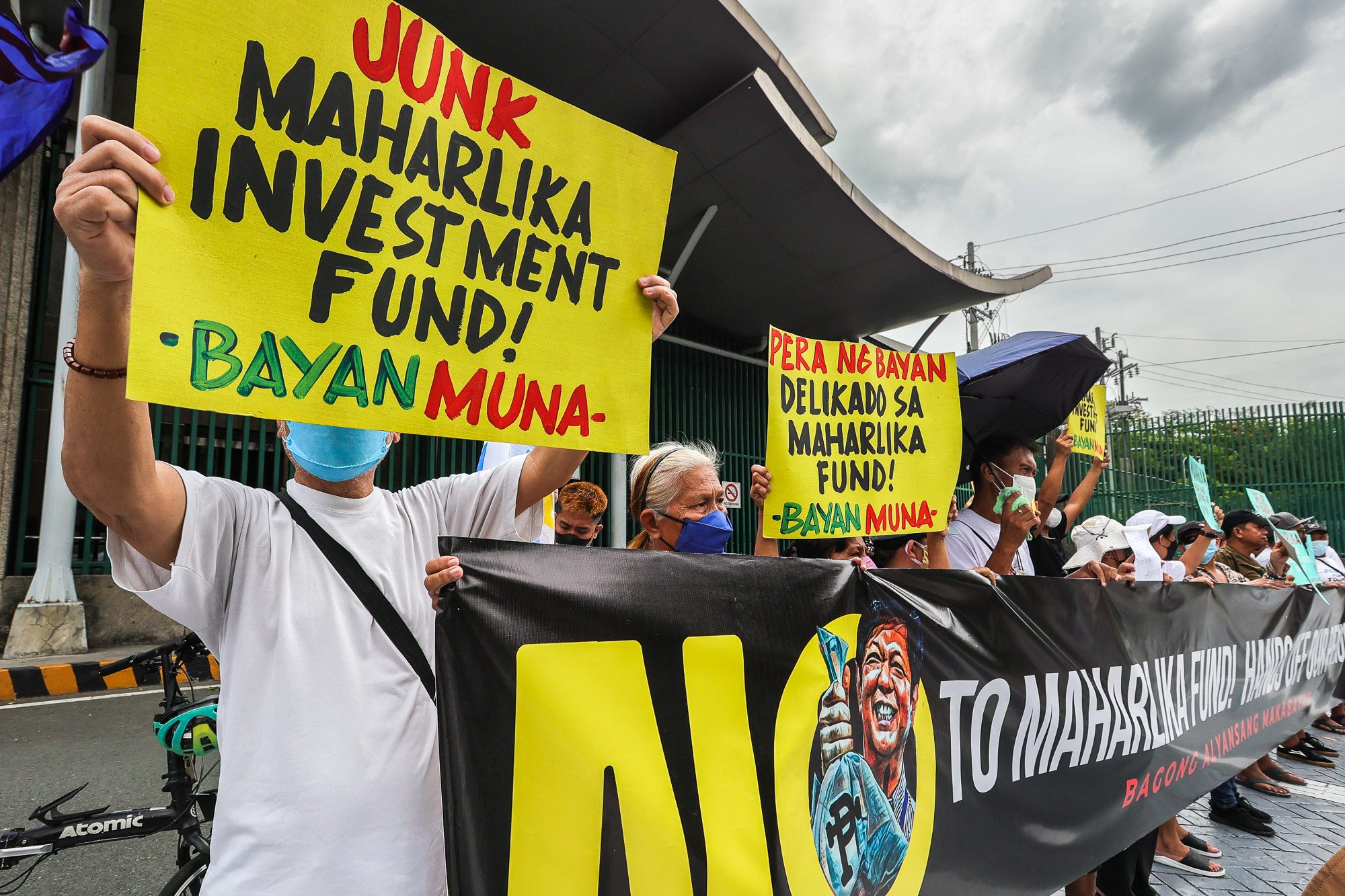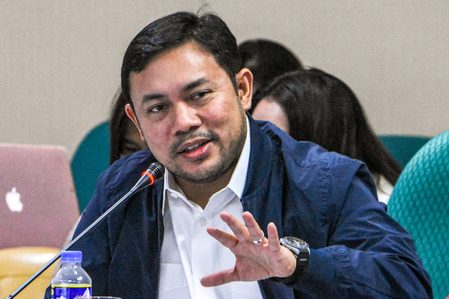SUMMARY
This is AI generated summarization, which may have errors. For context, always refer to the full article.

MANILA, Philippines – The controversial Maharlika fund proposal hurdled the Senate in a marathon session stretching past 2 am Wednesday, May 31. Later that same day, both chambers of Congress agreed to adopt the Senate version of the bill.
So how has the final version of the Maharlika Investment Fund (MIF) changed? Here are some key amendments in the Senate version of the bill.
1. No money from pension, welfare funds
Pension funds are now “absolutely prohibited” from investing in the Maharlika Investment fund. These include the Social Security System (SSS), Government Service Insurance System (GSIS), Philippine Health Insurance Corporation (PhilHealth), Home Development Mutual Fund (PAG-IBIG Fund), Overseas Workers Welfare Administration (OWWA), and Philippine Veterans Affairs Office (PVAO). The specific provision reads:
“[G]overnment agencies and GOCCs providing for the social security and public health insurance of government employees, private sector workers and employees, and other sectors and subsectors, such as but not limited to the SSS, GSIS, PhilHealth, PAG-IBIG Fund, OWWA, and PVAO Pension Fund shall be absolutely prohibited, whether mandatory or voluntary, to invest in the MIF.”
The original Senate bill prohibited these funds from being “requested or required to contribute to” the Maharlika Investment Corporation (MIC). But it left the door open for these agencies to invest in the fund, should they want to voluntarily.
Past attempts in the House to require the SSS and GSIS to contribute to the MIC’s capital sparked public protests, until both pension funds were eventually removed as funding sources.
Prior to the Senate bill’s amendment, Senator Risa Hontiveros warned that the GSIS was working to enter the Maharlika fund through a “backdoor” by having the board of the government pension fund change its investment strategy.
“Kapag pala binago lang ng GSIS Board ang kanilang investment strategy ay puwede nang isugal na rin ang lampas P1 trillion na pera ng GSIS sa Maharlika fund. At sa isang video nitong Abril, sinabi ni GSIS President Mr. Wick na nire-review at babaguhin daw ang investment strategies ng GSIS,” she said during the interpellation period on Monday, May 29.
(If the GSIS Board changes their investment strategy, they can gamble the more than P1 trillion funds of GSIS in the Maharlika fund. And in a video this April, GSIS President Wick Veloso said they are already reviewing and changing the investment strategies of GSIS.)
2. BSP dividend contribution tweaked
The Bangko Sentral ng Pilipinas (BSP) will now contribute 100% of its remittances during the first and second year of the Maharlika fund’s establishment, up to a maximum of P50 billion. The idea is to allow the BSP to use more of its dividends for its capital build-up.
Previously, the BSP was required to continue remitting its dividends to the Maharlika fund even after the first two years – all the way until the national government’s P50 billion contribution was fully paid.
Senator Sherwin Gatchalian attempted to exempt the BSP from contributing any of its dividends at all “to ensure BSP’s increasing capitalization will be fully realized at the earliest possible time.” But Senator Mark Villar – the sponsor of the Maharlika bill – struck down the proposed amendment.
3. Limits to capitalization and corporate term
The total investments from government financial institutions (GFI), such as the Land Bank of the Philippines (Landbank) and Development Bank of the Philippines (DBP) have also been capped at 25% of the GFI’s net worth.
For MIC’s seed money, Landbank will be contributing P50 billion while DBP will be investing P25 billion. The national government is also obligated to contribute P50 billion to the fund, which includes BSP’s dividends.
The MIC will have an authorized capital stock of P500 billion. Senators included an amendment requiring MIC to request Congress for legislation in the event that they need to increase the capitalization of MIC.
The MIC was also given a corporate term of 35 years from the date of effectivity of the act, unless Congress extends or repeals it sooner.
4. Changes to the board of directors
The composition of the nine-member board of directors remained largely unchanged, but Senator Risa Hontiveros added a provision in anticipation of the proposed merger of Landbank and DBP.
In case of a merger, consolidation, abolition, or dissolution involving either of the founding GFI, the board seat of the affected GFI will be occupied by the next highest ranking officer of the surviving GFI who assumed its rights.
For instance, in a Landbank-DBP merger, DBP will cease to exist and Landbank will be the surviving entity. This means that if the merger pushes through, the seat of the DBP on the board – which is normally occupied by the president and chief executive officer of the DBP – will now be occupied by an official from Landbank.
Persons with pending administrative, civil, or criminal cases relating to the misuse of money or breach of trust are also now disqualified from being a director.
5. Maharlika documents in Filipino
All documents relating to the MIF and MIC will also be made available in both English and Filipino. These include the investment policies, investment and risk management plans, statements of assets and liabilities (SALNs) of company officials, and audit documents from the Commission on Audit.
It was Senator Robin Padilla who added an amendment requiring that the documents be issued in both languages as he pointed out that many of those who do not support the bill say that they can’t understand what it’s about.
6. Heavier penalties for violations
Several amendments to the sections on offenses and penalties now impose heavier fines for violations. For instance, directors or officers found to have held office while possessing or concealing any grounds for disqualifications will face fines from P5 million to P7 million, along with perpetual disqualification from holding public office.
However, some penalties were not raised as high as originally proposed. Hontiveros pitched for directors or officers found guilty of graft and corruption to face fines of P20 million to P30 million and imprisonment of 20 years.
But Senator Jinggoy Estrade – who served jail time for plunder and graft charges related to the pork barrel scam – instead suggested lowering the fines to just P5 million to P10 million. This amendment was eventually accepted.
Lingering issues?
Even with the amendments, several critics still said that setting up the Maharlika fund will reroute money from other government projects into a fund that could further burden the public, if it were to fail.
“You have public money as the source funding the Maharlika Investment Fund, but what is the tradeoff? The tradeoff is, all of this public money is supposed to be part of public revenues to support the national budget,” said former BSP deputy governor Diwa Guinigundo on CNN Philippines’ The Source.
Guinigundo warned that to replenish that public money, the government may be forced to raise more taxes, borrow money domestically or abroad, or do both.
“So instead of addressing and mitigating the problems of high fiscal deficit and increasing level of public debt, this Maharlika Investment Fund may, in fact, worsen it,” he said on Wednesday.
He also emphasized that continuing to use the dividends of the BSP to provide startup capital for the Maharlika fund further delays the central bank’s capital buildup, which can be especially dangerous in the current economic circumstances – ironically, the same circumstances that led to Marcos certifying Maharlika as urgent in the first place.
“You need a central bank that is more highly capitalized so that you would be able to promote price stability and financial stability when the situation gets worse and the need for central bank is necessary,” he said. “Instead, these dividends will be transferred, will be earmarked for funding the Maharlika Investment Fund.”
Former director-general of the National Economic and Development Authority Winnie Monsod, speaking on ANC’s Headstart, also echoed the same concerns about the funding source for the MIF.
“This is not a sovereign wealth fund. I cannot see that it comes from government surpluses because we have no government surplus. It does not come from balance of payments surplus because we don’t have a balance of payments surplus,” she said on Wednesday.
“What you are doing with the sovereign wealth fund is you are creating an institution which could fail. And when that fails, the burden is going to be felt by the Filipino people,” she added. – Rappler.com
Add a comment
How does this make you feel?






![[WATCH] Bamban POGO scandal: There’s a bigger fish than Alice Guo](https://www.rappler.com/tachyon/2024/07/inside-track-tcard-bamban-pogo.jpg?resize=257%2C257&crop=435px%2C0px%2C1080px%2C1080px)
There are no comments yet. Add your comment to start the conversation.